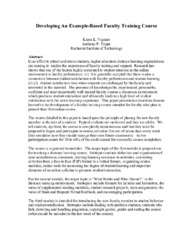Developing an example-based faculty training course
Abstract
Developing an example-based faculty training course
Karen K. Vignare
Anthony P. Trippe
Rochester Institute of Technology
Abstract
In an effort to attract and retain students, higher education distance learning organizations
are coming to realize the importance of faculty training and support. Research has
shown that one of the factors highly correlated to student retention in the online
environment is faculty performance. (1) It is generally accepted that there is also a
connection between student satisfaction with faculty performance and student learning.
(2) (3) Student satisfaction rises when students are challenged by the faculty and
interested in the material. The presence of knowledgeable, experienced, personable,
confident and most importantly well-trained faculty creates a classroom environment
which produces student interaction and ultimately leads to a high level of student
satisfaction with the entire learning experience. This paper/presentation describes lessons
learned in the development of a faculty training course intended for faculty who plan to
present their first online course.
The course detailed in this paper is based upon the principle of placing the new faculty
member in the role of a student. Typical students are motivated and they are adults. We
tell students, up-front, the course is completely asynchronous and that they must be
prepared to logon and participate in course activities five out of seven days every week
(this simulates how they should manage their own future classrooms). Active
participation counts for 30 to 40% of the credit earned for successful course completion.
The course is organized in modules. The major topic of the first module is preparations
for teaching a distance learning course. Subtopics include definition and organization of
your asynchronous classroom, relating learning outcomes to activities, converting
activities from a face to face (F2F) format to a virtual format, organizing course
modules, online tools for measuring the degree of student learning and important
elements of an online syllabus to promote student interaction.
For the second module, the major topic is “What Works and What Doesn't” in the
distance learning environment. Subtopics include formats for lectures and lecturettes, the
value of supplemental reading materials, student research projects, team assignments, the
value of frank and frequent formal feedback, and encouraging participation.
The third module is intended for introducing the new faculty member to student behavior
and student satisfaction. Subtopics include dealing with problem students, students who
lurk, detecting and handling plagiarism, copyright guides, grades and ending the course
(what should be included in the last week of the course).
In all phases of this course, the presentation, student participation and assignment
activities will mimic successful behaviors and approaches that promote learning and
student satisfaction in the distance learning classroom.
Bibliography
1. Thomerson, J.D. and Smith, C.L. (1996), Student perceptions of the affective
experiences encountered in distance learning courses, American Journal of
Distance Education, vol.10, no.3, 1996, pp.37-48.
2. Graham, C., Cagiltay, K., Lim, B., Craner, J., and Duffy, T. M. "Seven
Principles of Effective Teaching: A Practical Lens for Evaluating Online
Courses." The Technology Source, March/April 2001.
3. Gross, Ronald (1991), Peak Learning, ISBN: 0-87477-610-4, published by G. F.
Putnam’s Sons, New York.

